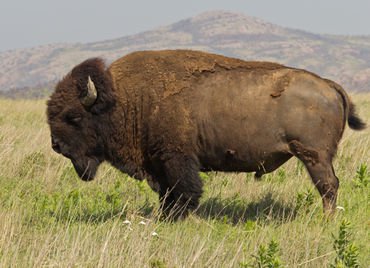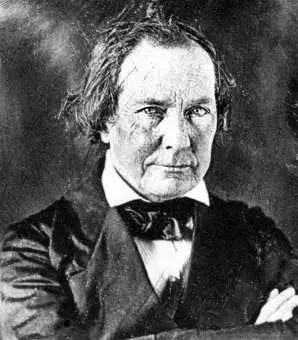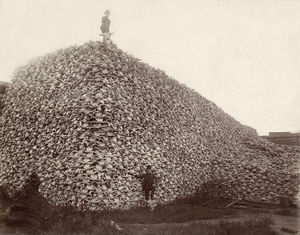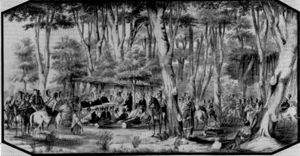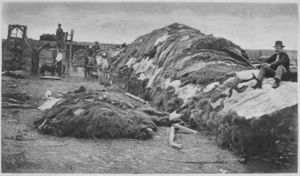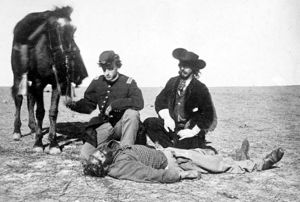Difference between revisions of "The Red River War, 1874-1875: What Were the Events that Led to the Uprising"
| Line 35: | Line 35: | ||
Medicine Lodge Creek, Kansas was the site of a meeting between the Department of Indian Affairs and several thousand Native Americans. The week of meetings that took place from October 21-28, 1867 was an attempt at appeasement on the part of the government. Treaties made that week between the Kiowa-Comanche association and the Cheyenne-Arapaho alliance were designed to afford some land to the Indians while assuring the safety of white hunters and migrants. | Medicine Lodge Creek, Kansas was the site of a meeting between the Department of Indian Affairs and several thousand Native Americans. The week of meetings that took place from October 21-28, 1867 was an attempt at appeasement on the part of the government. Treaties made that week between the Kiowa-Comanche association and the Cheyenne-Arapaho alliance were designed to afford some land to the Indians while assuring the safety of white hunters and migrants. | ||
[[File:medicine lodge peace council.jpg|thumbnail|300px|Depiction of the Medicine Lodge Peace Council, Medicine Lodge, Kansas, 1867.]] | [[File:medicine lodge peace council.jpg|thumbnail|300px|Depiction of the Medicine Lodge Peace Council, Medicine Lodge, Kansas, 1867.]] | ||
| − | The Kiowa-Comanche treaty was signed on October 21, 1867 and the Cheyenne-Arapaho chiefs signed their treaty one week later. The treaties mandated that the native tribes were to reside on reservation land within Indian Territory (present day Oklahoma) and were to receive provisions, including food stuffs and ammunition, at the expense of the federal government. Further, excepting government agents, whites were forbidden from trespassing on reservation land and that the territory designated was for the “absolute and undisturbed use and occupation of the Indians herein named.” Further, a clause was incorporated allowing the Native tribes “the right to hunt on any lands south of the Arkansas River so long as the buffalo may range thereon.”<ref>Charles J. Kappler, compiler and editor, ''Indian Affairs: Laws and Treaties — Vol. II: Treaties'', (Washington, D.C.: Government Printing Office, 1904), 977-989.</ref>The tribal chiefs were resigned to the terms of the treaty; however, became angry when they were not given their allotment of weapons and supplies. Viewing the slight as an act of betrayal, young warrior bands from the Cheyenne tribe lit out on raiding expeditions to obtain what was necessary for their families. The federal government became enraged with the actions of the individual warrior bands and bolstered its complement of troops in the region. As the reinforcements arrived, General Sherman stated, “‘I will say nothing and do nothing to restrain our troops,’” as Sherman viewed native Americans as “‘the enemies of our [white] race and civilization.’”<ref>Quoted in Robert M. Utley, ''Frontier Regulars: The United States Army and the Indians, 1866-1891'' (New York: Macmillan, 1973),150-52.</ref>Sherman’s barrage of attacks on the South Plains Indians were stifled the following year when his former commanding general became his Commander-in-Chief. | + | The Kiowa-Comanche treaty was signed on October 21, 1867 and the Cheyenne-Arapaho chiefs signed their treaty one week later. The treaties mandated that the native tribes were to reside on reservation land within Indian Territory (present day Oklahoma) and were to receive provisions, including food stuffs and ammunition, at the expense of the federal government. Further, excepting government agents, whites were forbidden from trespassing on reservation land and that the territory designated was for the “absolute and undisturbed use and occupation of the Indians herein named.” Further, a clause was incorporated allowing the Native tribes “the right to hunt on any lands south of the Arkansas River so long as the buffalo may range thereon.”<ref>Charles J. Kappler, compiler and editor, ''Indian Affairs: Laws and Treaties — Vol. II: Treaties'', (Washington, D.C.: Government Printing Office, 1904), 977-989.</ref> |
| + | |||
| + | The tribal chiefs were resigned to the terms of the treaty; however, became angry when they were not given their allotment of weapons and supplies. Viewing the slight as an act of betrayal, young warrior bands from the Cheyenne tribe lit out on raiding expeditions to obtain what was necessary for their families. The federal government became enraged with the actions of the individual warrior bands and bolstered its complement of troops in the region. As the reinforcements arrived, General Sherman stated, “‘I will say nothing and do nothing to restrain our troops,’” as Sherman viewed native Americans as “‘the enemies of our [white] race and civilization.’”<ref>Quoted in Robert M. Utley, ''Frontier Regulars: The United States Army and the Indians, 1866-1891'' (New York: Macmillan, 1973),150-52.</ref>Sherman’s barrage of attacks on the South Plains Indians were stifled the following year when his former commanding general became his Commander-in-Chief. | ||
In 1869, President Ulysses S. Grant altered the intentions of the U.S. government’s relationship with Native American tribes on the South Plains. Grant was striving for a peaceful resolution with the South Plains Indians. His first act in this struggle was to remove the Indian Bureau from the War Department and place it under the jurisdiction of the Department of Interior. In assigning agents to work with Native tribes, he replaced military officers with religious leaders in an attempt to constrain and Christianize the Indian peoples. He enlisted Quaker Elders John D. Miles and James M. Haworth as agents on the reservations. Miles oversaw the Darlington Agency, which was home to the Cheyenne-Arapaho alliance, while Haworth was agent to the Kiowa-Comanche confederation at Fort Sill.<ref>Haley, 12-16.</ref>Although the motivation behind Grant’s strategy of attaining peace was admirable, a lack of treaty enforcement, the disdain of forced religion felt by the Native Americans, and the xenophobic attitudes of those in positions of governmental authority offered little hope of the plan succeeding. | In 1869, President Ulysses S. Grant altered the intentions of the U.S. government’s relationship with Native American tribes on the South Plains. Grant was striving for a peaceful resolution with the South Plains Indians. His first act in this struggle was to remove the Indian Bureau from the War Department and place it under the jurisdiction of the Department of Interior. In assigning agents to work with Native tribes, he replaced military officers with religious leaders in an attempt to constrain and Christianize the Indian peoples. He enlisted Quaker Elders John D. Miles and James M. Haworth as agents on the reservations. Miles oversaw the Darlington Agency, which was home to the Cheyenne-Arapaho alliance, while Haworth was agent to the Kiowa-Comanche confederation at Fort Sill.<ref>Haley, 12-16.</ref>Although the motivation behind Grant’s strategy of attaining peace was admirable, a lack of treaty enforcement, the disdain of forced religion felt by the Native Americans, and the xenophobic attitudes of those in positions of governmental authority offered little hope of the plan succeeding. | ||
| Line 64: | Line 66: | ||
The Red River War was a series of engagements fought between the United States Army and the war parties of the Kiowa, Comanche, Arapaho, and Cheyenne tribes. By enabling white buffalo hunters to breach the Medicine Lodge Treaty, the military leaders fostered the desire for war among the war factions of the tribes. Further, the neglect on the part of the federal government to provide rations to the peaceful reservation Indians exacerbated the feeling among the tribes that they needed to feed and protect themselves. In the early part of May 1874, agent Miles had no food to provide and the nearest herds of buffalo were more than one hundred-fifty miles from the Cheyenne-Arapaho reservation. Miles had no choice but to allow his tribes off the reservation in order to hunt buffalo. These two tribes proceeded in the direction of the Staked Plains on the Texas panhandle where they encountered the white hunting parties at a settlement named Adobe Walls. This was the beginning of the Red River War. | The Red River War was a series of engagements fought between the United States Army and the war parties of the Kiowa, Comanche, Arapaho, and Cheyenne tribes. By enabling white buffalo hunters to breach the Medicine Lodge Treaty, the military leaders fostered the desire for war among the war factions of the tribes. Further, the neglect on the part of the federal government to provide rations to the peaceful reservation Indians exacerbated the feeling among the tribes that they needed to feed and protect themselves. In the early part of May 1874, agent Miles had no food to provide and the nearest herds of buffalo were more than one hundred-fifty miles from the Cheyenne-Arapaho reservation. Miles had no choice but to allow his tribes off the reservation in order to hunt buffalo. These two tribes proceeded in the direction of the Staked Plains on the Texas panhandle where they encountered the white hunting parties at a settlement named Adobe Walls. This was the beginning of the Red River War. | ||
| − | |||
| − | |||
<div class="portal" style="width:85%;"> | <div class="portal" style="width:85%;"> | ||
==Related DailyHistory.org Articles== | ==Related DailyHistory.org Articles== | ||
| Line 74: | Line 74: | ||
*[[What was the impact of the Paris Commune of 1871 on Revolutionaries?]] | *[[What was the impact of the Paris Commune of 1871 on Revolutionaries?]] | ||
</div> | </div> | ||
| + | {{Mediawiki:Gilded Age}} | ||
| + | ==References== | ||
| + | <references/> | ||
[[Category:Wikis]] [[Category:19th Century History]] [[Category:United States History]] [[Category:Native American History]] | [[Category:Wikis]] [[Category:19th Century History]] [[Category:United States History]] [[Category:Native American History]] | ||
{{Contributors}} | {{Contributors}} | ||
| − | |||
Revision as of 04:32, 30 December 2016
The tribes which inhabited the southern plains of the United States, aptly called the “Buffalo Indians,” all originated in another region of North America. As the 19th century progressed, these groups of people were well adapted and thrived in their environment. The middle of the century; however, proved to be increasingly challenging to the Native American tribes as the U.S. government sought to contain, if not eliminate, these nomadic hunters in order to exploit the region and its resources for the advancement of westward expansion. In 1865 the American Civil War had at last come to an end, thus allowing for an increased military presence in Texas and the Southern Plains region. Further, the intercontinental railroad was completed in 1868, which increased the rate of the transportation of goods to the East and migrant settlers to the West.
The threat of civilians encountering hostile Native tribes was prevalent; therefore, in order for the U.S. government to promote white settlement in the Southern Plains, the “Indian Problem,” needed to be swiftly addressed. The Indian Bureau and Native Americans of the region agreed to treaties, which skewed largely in favor of the government and were scantily enforced. Native elders saw little choice but to sign the treaties as they were aware of the might of the Federal Army and understood that without the pacts, the possibility of a war was likely. When the treaties went unenforced and the Native Americans got little of the relief promised by the government, war did in fact follow. The Red River Uprising of 1874-1875 pitted the South Plains tribes against the U.S. Army and proved to be the final Indian war in the region. Tensions had risen in the region over several decades; however, the outbreak of war in 1874 was due to the encroachment of white buffalo hunters onto Native American soil, the lack of enforcement of the Medicine Lodge Treaty, and the attitudes of military leaders toward Native Americans.
Mexican-American War
Samuel Houston became the second president of independent Texas and attempted to affect territorial compromises with the Plains tribes. Relative peace ensued until his successor, Mirabeau Lamar, assumed the office in 1839, whereupon he sought “‘an exterminating war upon their [South Plains tribes] warriors; which will admit no compromise and have no termination except in their total extinction or total expulsion.’”[1]Within seven years of Lamar’s statement, the U.S. became embroiled in a war with Mexico that was directly impacted by the South Plains Indians.
In order to arrive at the theater of war, federal troops needed to traverse Indian territories along the Santa Fe Trail. In order to ensure the safety of his army, President James K. Polk invited chiefs from all of the tribes to Washington City. Forty-one chiefs made the trip to the nation’s capital and reached an agreement with Polk. The native tribes agreed to allow the military forces to pass unscathed in exchange for food and provisions supplied by the federal Government and a guarantee from Polk that the United States, which had annexed Texas in 1845, would not interfere with the tribal raids into Old Mexico. A similar agreement; however, was made with Mexico at the conclusion of the war.
The Treaty of Guadalupe Hidalgo was agreed upon in 1848 by both governments after the United States claimed victory in the Mexican-American War. The most significant outcome of the treaty was the new boundaries established for each nation. More importantly to the native tribes was a promise of the U.S. delegates to prevent Native American raids into Mexico; this was a direct contradiction to the promise made two years earlier to the tribal chiefs. As the United States deemed the relationship with Mexico of greater importance than that of its relationship with the South Plains tribes, military forts and outposts arose in Texas for the purpose of patrolling the newly established national borders. Further, with the increased military presence the soldiers were also able to guard the boundaries of the southern and western frontiers from the South Plains tribes.
South Plains Tribes
The tribes that composed the South Plains Indians were the Kiowa, Comanche, Cheyenne, and Arapaho. Each of these groups migrated to the region out of necessity. The Comanche migrated south from the North Plains region of the United States near the onset of the 18th century. Following soon after was the Kiowa tribe. Before the arrival of the Kiowa, the Comanche enjoyed the abundance of fertile hunting grounds the southern plains had to offer and immediately became hostile towards the Kiowa upon their arrival. Over the years, the two tribes engaged in territorial fighting until in 1795 they agreed to form the Kiowa-Comanche Confederation.[2]
The new century brought new tribes to the southern plains when in 1830 the Cheyenne and Arapaho arrived from the Great Lakes region. The Apache, who occupied the South Plains prior to the arrival of the Kiowa-Comanche and Cheyenne-Arapaho bands, were driven from the plains into the desert Southwest. With continued raids into Mexico (and before that New Spain) and an acumen for making profitable trades, the four tribes were able to acquire a large stock of arms and horses. By doing so they were able to increase their hunting expeditions and further hone their skills.
The South Plains tribes were dependent on buffalo for their very existence. The grasses of the plains were considered premier grazing grounds, thus the animals of the region were not only in abundance but well-nourished and vigorous; therefore, they provided good meat and healthy hides. Aside from being the main dietary staple of these tribes, the buffalo provided nearly every necessity of life for Plains dwellers; no part of the animal was wasted. Buffalo hair was woven into ropes, tendons were used for bow strings, bones and horns were used as tools and utensils, bladders were dried for canteens, and hides were used for shelter and clothing.[3]Without this animal, the South Plains Indians could not exist. For the tribes, the buffalo was seen as a giver-of-life, whereas white hunters saw the beast as a means by which to gain wealth.
Buffalo Hunters
In 1870, a new process was developed for tanning hides, thereby making hunting a lucrative endeavor. It was in that year that Josiah Wright Mooar departed his New England home in pursuit of converting buffalo hunting into a lucrative business. Coinciding with the new tanning process was the increased interest in using buffalo hides as sleigh blankets in the eastern states. Mooar came to realize the monetary potential in hides. With the help of his brother, he negotiated a contract to provide 2,000 hides and be compensated $3.50 for each.[4]
Word of the Mooar’s business rapidly spread throughout the hunting community and Dodge City, Kansas soon became the hub of buffalo hunting. The animal was present in incalculable abundance in the mid-19th century thereby affording a great number of hunters a lucrative livelihood. In just three years, 1872-1874, the number of hides exported by rail alone was 4,373,730.[5] In 1877, English traveler William Blackmore wrote:
"In the Autumn of 1868, whilst crossing the plains on the Kansas Pacific Railroad…we passed through an almost unbroken herd of buffalo. The Plains were blackened with them, and more than once the train had to stop to allow unusually large herds to pass. A few years afterwards, when travelling over the same line of railroad, it was a rare sight to see a few herds from ten to twenty buffalo.” "[6]
With isolated exceptions, this mass hunting took place north of the Arkansas River; therefore, the hunters acted in accordance with the treaties agreed upon by the South Plains tribes and the United States government.
The Medicine Lodge Treaty
Medicine Lodge Creek, Kansas was the site of a meeting between the Department of Indian Affairs and several thousand Native Americans. The week of meetings that took place from October 21-28, 1867 was an attempt at appeasement on the part of the government. Treaties made that week between the Kiowa-Comanche association and the Cheyenne-Arapaho alliance were designed to afford some land to the Indians while assuring the safety of white hunters and migrants.
The Kiowa-Comanche treaty was signed on October 21, 1867 and the Cheyenne-Arapaho chiefs signed their treaty one week later. The treaties mandated that the native tribes were to reside on reservation land within Indian Territory (present day Oklahoma) and were to receive provisions, including food stuffs and ammunition, at the expense of the federal government. Further, excepting government agents, whites were forbidden from trespassing on reservation land and that the territory designated was for the “absolute and undisturbed use and occupation of the Indians herein named.” Further, a clause was incorporated allowing the Native tribes “the right to hunt on any lands south of the Arkansas River so long as the buffalo may range thereon.”[7]
The tribal chiefs were resigned to the terms of the treaty; however, became angry when they were not given their allotment of weapons and supplies. Viewing the slight as an act of betrayal, young warrior bands from the Cheyenne tribe lit out on raiding expeditions to obtain what was necessary for their families. The federal government became enraged with the actions of the individual warrior bands and bolstered its complement of troops in the region. As the reinforcements arrived, General Sherman stated, “‘I will say nothing and do nothing to restrain our troops,’” as Sherman viewed native Americans as “‘the enemies of our [white] race and civilization.’”[8]Sherman’s barrage of attacks on the South Plains Indians were stifled the following year when his former commanding general became his Commander-in-Chief.
In 1869, President Ulysses S. Grant altered the intentions of the U.S. government’s relationship with Native American tribes on the South Plains. Grant was striving for a peaceful resolution with the South Plains Indians. His first act in this struggle was to remove the Indian Bureau from the War Department and place it under the jurisdiction of the Department of Interior. In assigning agents to work with Native tribes, he replaced military officers with religious leaders in an attempt to constrain and Christianize the Indian peoples. He enlisted Quaker Elders John D. Miles and James M. Haworth as agents on the reservations. Miles oversaw the Darlington Agency, which was home to the Cheyenne-Arapaho alliance, while Haworth was agent to the Kiowa-Comanche confederation at Fort Sill.[9]Although the motivation behind Grant’s strategy of attaining peace was admirable, a lack of treaty enforcement, the disdain of forced religion felt by the Native Americans, and the xenophobic attitudes of those in positions of governmental authority offered little hope of the plan succeeding.
The South Plains Indians were superstitious, nomadic hunters who were forced into confinement, reeducated as pastoralists, and mandated to adopt a foreign and unwelcome religion. Christianity was not an optional pursuit for those living on reservation land. In his 1872-1873 annual report, Secretary of the Interior Columbus Delano wrote:
“‘our civilization ought to take the place of their barbarous habits…I would not seriously regret the total disappearance of the buffalo from our western prairies, in its effect upon the Indians, regarding it rather as a means of hastening the sense of dependence upon the products of the soil.’”[10]
This attitude was not unique to Delano. Sherman felt great hostility toward the Native Americans as did the majority of his officers and troops. With that as a basis for motivation, it is not surprising that the U.S. Army did not afford the tribes adequate protection when white hunters began to violate the Medicine Lodge Treaty.
Enabling Treaty Violations
Hunting buffalo had become a wildly popular means by which to make a living and the number of hunters pouring into Dodge City grew at an exponential rate. Renowned hunter William “Billy” Dixon wrote that “During the fall and winter of 1872 and 1873, there were more hunters in the country than ever before…I feel safe in saying that 75,000 buffaloes were killed within sixty or seventy-five miles of Dodge.”[11]The result of such voracious hunting was the decimation of the animal north of the Arkansas River.
The white men inched their way down through Kansas and into Indian Territory one river at a time. The initial southern hunting boundary of the Medicine Lodge Treaty was the Arkansas River; what the hunters called the “Dead Line.” After crossing the Arkansas, they moved in order to the Cimarron, Canadian, and finally the Red River. The U.S. Army turned the other way when they saw the trespassing, hunting, and poaching of what, by treaty, belonged to the Native Americans. By 1873, the tribal leaders realized they were unable to prevent the hunters from infringing on their territory, thus they elected to remain on the reservations rather than hunt on their own land. Factions within tribes began to quarrel as most sought peace while a growing number of war chiefs and young warriors began to emerge. Actions of the hunters exacerbated the path to war in 1873 when they scouted the Texas panhandle.
While on his scouting expedition, Josiah Wright Mooar realized the abundance of buffalo in the region. The potential earnings seemed great; however, in order to reach the plentiful grounds, the hunters had violate the treaty by passing through Indian lands. Wright Mooar met with Major Richard Dodge, the commander of Fort Dodge, and asked the military’s stance on treaty violations. Major Dodge shared the opinions of many high ranking military officers regarding Native Americans and assured Mooar that he would not encounter any interference from his troops. With the tacit consent from Major Dodge, Mooar coordinated the other white hunters into a party to pursue buffalo on the Staked Plains of the Texas panhandle. By working in this region, the white hunters violated the Medicine Lodge Treaty by taking buffalo south of the designated border and trespassing on tribal territory. They were able to do this due to the lack of enforcement on the part of the United States Army.
Native American Frustrations
By the early part of 1874, the majority of South Plains Indians had resigned themselves to the reality that due to the military power of the federal government they had no choice but to concede to the demands white Americans. Chiefs arrived with their tribes at the designated reservations as they were promised protection and rations. The government did not provide the promised food and supplies, thus the frustrations grew among the tribal warriors. Additionally, white hunters and pioneers began poaching Indian horses without facing any consequences for their actions.
Cries for war were increasing at Darlington and agent Miles grew concerned. He wrote that “‘The Chiefs are very much provoked and discouraged…and express the fear that, should nothing be done…and another raid be maid upon them, that it will be impossible for them to restrain their young men from making a like raid on the frontier of Kansas.’”[12]Again, nothing was done to punish the white criminals and the robberies and poaching continued.
At Fort Sill, agent Haworth was faced with the same problem in that his Indian wards were suffering the same deprivations as those at Darlington. Agent Haworth wrote that “‘Since the Indians have camped near the agency, over one hundred head of their stock have been stolen and taken into Texas ̶ ̶ ̶ and none recovered.’”[13]Compounding the problem of the robberies was the fact that the horse thieves were at times forced to kill other white men and did so in a manner that suggested the killings were perpetrated by Native Americans. They took scalps, which was the tradition of Native Americans, and convinced the frontier citizens that that it was the South Plains Indians who were guilty. Agent Haworth defended the tribes and wrote, “‘I am fully convinced that many of the offences charged to the Indians are committed by white men in disguise.’”[14]
Native American chiefs were also aware of the trickery being enacted by the thieves, which increased the call for war. By spring 1874, hungry South Plains tribes had been infringed upon, neglected, stolen from, and framed for murders of which they were innocent. Their increased anger and hatred of white hunters and the U.S. government had been simmering for years and at last reached the boiling point when hunters established a settlement on the Texas panhandle.
Conclusion
The Red River War was a series of engagements fought between the United States Army and the war parties of the Kiowa, Comanche, Arapaho, and Cheyenne tribes. By enabling white buffalo hunters to breach the Medicine Lodge Treaty, the military leaders fostered the desire for war among the war factions of the tribes. Further, the neglect on the part of the federal government to provide rations to the peaceful reservation Indians exacerbated the feeling among the tribes that they needed to feed and protect themselves. In the early part of May 1874, agent Miles had no food to provide and the nearest herds of buffalo were more than one hundred-fifty miles from the Cheyenne-Arapaho reservation. Miles had no choice but to allow his tribes off the reservation in order to hunt buffalo. These two tribes proceeded in the direction of the Staked Plains on the Texas panhandle where they encountered the white hunting parties at a settlement named Adobe Walls. This was the beginning of the Red River War.
Related DailyHistory.org Articles
- Why Was Vicksburg “The Gibraltar of the Confederacy?”
- Interview:African American Soldiers During the Civil War: Interview with Author Bob Luke
- Why Was the Battle of Antietam a Pivotal event in the American Civil War?
- Gilded Age/Progressive Era History Top Ten Booklist
- What was the impact of the Paris Commune of 1871 on Revolutionaries?
References
- ↑ Quoted in James L. Haley, The Buffalo War (New York: Doubleday, 1976), 4-5.
- ↑ Haley, 1.
- ↑ Haley, 37
- ↑ Haley, 21-22.
- ↑ Haley, 22.
- ↑ William Blackmore, “Introduction,” in Richard Irving Dodge, The Plains of the Great West (London: Chatto&Windus, 1877), xiv-xvi.
- ↑ Charles J. Kappler, compiler and editor, Indian Affairs: Laws and Treaties — Vol. II: Treaties, (Washington, D.C.: Government Printing Office, 1904), 977-989.
- ↑ Quoted in Robert M. Utley, Frontier Regulars: The United States Army and the Indians, 1866-1891 (New York: Macmillan, 1973),150-52.
- ↑ Haley, 12-16.
- ↑ Quoted in Haley, 38.
- ↑ Frederick S. Barde, Life and Adventures of “Billy” Dixon of Adobe Walls, Panhandle, Texas (Guthrie, OK: Cooperative Publishing Co., 1914), 109-110.
- ↑ Quoted in Haley,45
- ↑ Quoted in Haley, 47.
- ↑ Quoted in Haley, 48.
Admin, Costello65 and EricLambrecht
